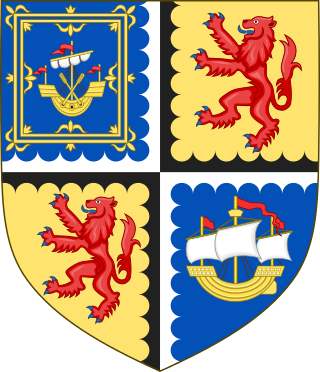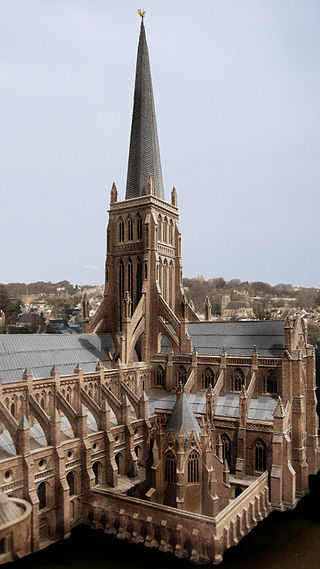Bibliography
- Watt, D.E.R., Fasti Ecclesiae Scoticanae Medii Aevi ad annum 1638, 2nd edition, (St Andrews, 1969), pp. 261–3
- Smith, Brian, Archdeacons of Shetland 1195–1567, in Ecclesia Nidrosiensis 1153-1537, (Trondheim 2003)
The Archdeacon of Shetland was the head of the Archdeaconry of Shetland, a sub-division of the Diocese of Orkney in Scotland This archdeacon was one of the two archdeacons of the diocese, the other being the Archdeacon of Orkney. Next to the bishop, the Archdeacon of Shetland was the senior ecclesiastic in the diocese.
The Lord Chancellor of Scotland, formally the Lord High Chancellor, was a Great Officer of State in the Kingdom of Scotland.

The Dean of St Patrick's Cathedral is the senior cleric of the Protestant St Patrick's Cathedral, Dublin, elected by the chapter of the cathedral. The office was created in 1219 or 1220, by one of several charters granted to the cathedral by Archbishop Henry de Loundres between 1218 and 1220.

The Prior, then Abbot and then Commendator of Dunfermline was the head of the Benedictine monastic community of Dunfermline Abbey, Fife, Scotland. The abbey itself was founded in 1128 by King David I of Scotland, but was of earlier origin. King Máel Coluim mac Donnchada had founded a church there with the help of Benedictines from Canterbury. Monks had been sent there in the reign of Étgar mac Maíl Choluim and Anselm had sent a letter requesting that Étgar's brother and successor King Alaxandair mac Maíl Coluim protect these monks. By 1120, when Alaxandair sent a delegation to Canterbury to secure Eadmer for the bishopric of St Andrews, there is a Prior of the Dunfermline monks by the name of Peter leading the delegation. Control of the abbey was secularized in the 16th century and after the accession of James Stewart in 1500, the abbey was held by commendators. In the second half of the 16th century, the abbey's lands were being carved up into lordships and it was finally annexed to the crown in July, 1593.
The Archdeacon of Lothian was the head of the Archdeaconry of Lothian, a sub-division of the Diocese of St Andrews. The position was one of the most important positions within the medieval Scottish church; because of his area's large population and high number of parish churches, the Archdeacon of Lothian may have exercised more power than many Scottish bishops before the decline in archdiaconal powers after the 13th century.
The Archdeacon of St Andrews was the head of the Archdeaconry of St Andrews, a sub-division of the Diocese of St Andrews, from the twelfth to the seventeenth century. The position was one of the most important positions within the medieval Scottish church; because of his area's large population and high number of parish churches, the Archdeacon of St Andrews may have exercised more power than many Scottish bishops. The following is a list of known archdeacons:
The Prior of Coldingham was the head of the Benedictine monastic community of Coldingham Priory in Berwickshire, Scotland. The priory was founded in the reign of David I of Scotland, although his older brother and predecessor King Edgar of Scotland had granted the land of Coldingham to the Church of Durham in 1098 AD, and a church was constructed by him and presented in 1100. The first prior is on record by the year 1147, although an earlier foundation is almost certain. The monastic cell was a dependent of Durham until the 1370s, and in 1378 King Robert II of Scotland expelled the Durham monks; for the following century the cell had two priors, one chosen by Durham and one chosen by the Scots. It became a dependent of Dunfermline Abbey. It was subject to increasingly secular control from the late 15th century into the 16th century.
The Archdeacon of Galloway was the only archdeacon in the medieval Diocese of Galloway (Whithorn), acting as a deputy of the Bishop of Galloway. The following is a list of archdeacons:
The Archdeacon of Ross was the only archdeacon in the medieval Diocese of Ross, acting as a deputy of the Bishop of Ross. The following is a list of archdeacons:
The Archdeacon of Caithness was the only archdeacon in the Diocese of Caithness, acting as a deputy of the Bishop of Caithness. The following is a list of known historical archdeacons:
The Archdeacon of Aberdeen was the only archdeacon in the Diocese of Aberdeen, acting as a deputy of the Bishop of Aberdeen. The archdeacon held the parish church of Rayne as a prebend since 1256. The following is a list of known historical archdeacons:
The Archdeacon of Moray was the only archdeacon in the Diocese of Moray, acting as a deputy of the Bishop of Moray. The archdeacon held the parish churches of Forres and Edinkillie as a prebends since 1207. The following is a list of known historical archdeacons:
The Archdeacon of Orkney was the head of the Archdeaconry of Orkney, a sub-division of the Diocese of Orkney in Scotland. This archdeacon was one of the two archdeacons of the diocese, the other being the Archdeacon of Shetland.
The Archdeacon of Brechin was the only archdeacon in the diocese of Brechin, acting as a subordinate of the Bishop of Brechin. The archdeacon held the parish church of Strachan as a prebend from at least 1274.

John Sinclair was a Scottish nobleman, 3rd Earl of Caithness and chief of the Clan Sinclair, a Scottish clan of the Scottish Highlands.
The Dean of Waterford in the United Dioceses of Cashel and Ossory in the Church of Ireland is the dean of Christ Church Cathedral, Waterford.

The Dean and Chapter of St Paul's Cathedral was the titular corporate body of St Paul's Cathedral in London up to the end of the twentieth century. It consisted of the dean and the canons, priests attached to the cathedral who were known as "prebendaries" because of the source of their income. The Dean and Chapter was made up of a large number of priests who would meet "in chapter", but such meetings were infrequent and the actual governance was done by the Administrative Chapter headed by the dean, made up of several senior "residentiary canons", who were also known as the "Dean and Canons of St Paul’s" or simply "The Chapter".